
Insects in the family Tettigoniidae are commonly called katydids or bush crickets. They have previously been known as "long-horned grasshoppers". More than 8,000 species are known. Part of the suborder Ensifera, the Tettigoniidae are the only extant (living) family in the superfamily Tettigonioidea.

Gryllinae, or field crickets, are a subfamily of insects in the order Orthoptera and the family Gryllidae.
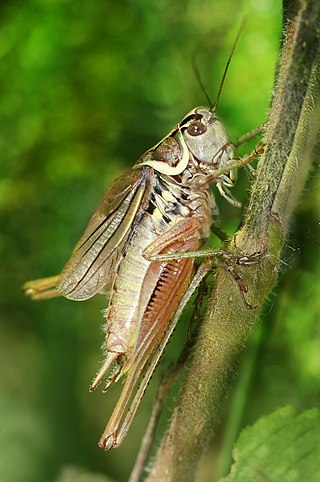
Roesel's bush-cricket, Roeseliana roeselii is a European bush-cricket, named after August Johann Rösel von Rosenhof, a German entomologist.

The wart-biter is a bush-cricket in the family Tettigoniidae. Its common and scientific names derive from the eighteenth-century Swedish practice of allowing the crickets to nibble at warts to remove them.

Saga pedo is a species of wingless bush cricket from the southern half of Europe and western and central Asia. This brown or green bush cricket typically has a total length, from the head to the tip of the ovipositor, of up to 10.5 cm (4.1 in), but exceptionally it may reach 12 cm (4.7 in), which makes it one of the largest European insects and one of the world's largest Orthoptera. The head-and-body alone typically is 5–7 cm (2.0–2.8 in) long in adults, but may reach up to 7.8 cm (3.1 in).

Gryllotalpa gryllotalpa, commonly known as the European mole cricket, is widespread in Europe and has been introduced to the eastern United States. Its scientific name is derived from the Latin 'gryllus' (cricket); and 'talpa' (mole), because of the fine dense fur which covers it and its subterranean habits, and because of the mole-like forelegs adapted for digging, a good example of convergent evolution.

Metaplastes pulchripennis, common name Italian ornate bush-cricket, is a species of 'katydids crickets' belonging to the family Tettigoniidae subfamily Phaneropterinae.

Tettigonia is the type genus of bush crickets belonging to the subfamily Tettigoniinae. The scientific name Tettigonia is onomatopoeic and derives from the Greek τεττιξ, meaning cicada.

Yersinella raymondii, common name Raymond's bush-cricket, is a species of "katydids crickets" belonging to the family Tettigoniidae subfamily Tettigoniinae. The scientific name Yersinella comes from the name of the entomologist who has described the species in 1860.

Pholidoptera griseoaptera, the dark bush-cricket, is a flightless species of European bush-cricket; it is the type species of its genus with no subspecies.

Barbitistes obtusus, the southern saw-tailed bush-cricket or Alpine saw bush-cricket, is a species of bush crickets in the subfamily Phaneropterinae.

Antaxius pedestris is a species of "bush crickets" belonging to the family Tettigoniidae. It was originally described by Johan Christian Fabricius under the scientific name of Locusta pedestris.

Anurogryllus muticus, also known as De Geer's short-tailed cricket or simply short-tailed cricket is a species of cricket in the family Gryllidae.
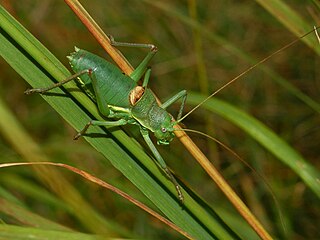
Ephippiger perforatus, the North Apennine saddle bush-cricket, is a species of insect in the family Tettigoniidae.
Orthelimaea is a genus of Asian bush crickets in the subfamily Phaneropterinae. Species in this genus are found in India, Indo-China, and Malesia.
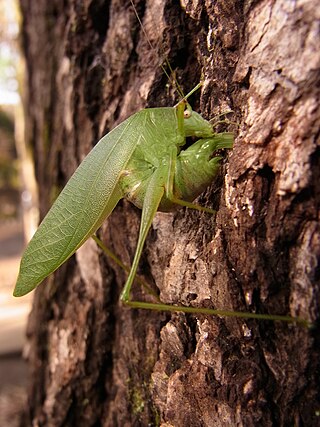
Holochlora japonica, the Japanese broadwinged katydid, is a species of katydid or bush cricket native to eastern Asia in the large subfamily Phaneropterinae.

Anderus maculifrons is a species of ground wētā endemic to New Zealand. They are nocturnal, carnivorous, and flightless orthopterans belonging to the family Anostostomatidae. Being a nocturnal species, individuals remain in tunnels in the ground during the day and emerge from their burrows after sunset to forage and hunt for small invertebrates. Anderus maculifrons is one of the smallest New Zealand weta species, averaging 15 mm in length and weighing 1–3 g. Unlike the tree weta and tusked weta, where sexual dimorphism is found in the form of male weaponry, ground weta only exhibit sexual size dimorphism: the females are larger than the males.
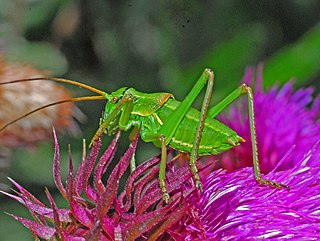
Ephippiger terrestris, common name Alpine saddle-backed bush-cricket, is a bush cricket species belonging to the family Tettigoniidae, subfamily Bradyporinae.
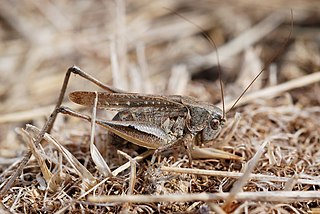
Platycleis grisea is a European species of bush crickets described by Fabricius in 1781. It is the type species of the genus Platycleis and therefore the tribe Platycleidini. This species is recorded from mainland Europe and northern Africa.
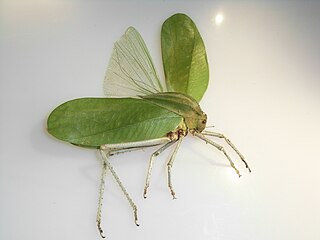
Siliquofera is a genus of bush cricket in the subfamily Phyllophorinae that includes only one species, Siliquofera grandis, which is fairly common and widespread in rainforest canopies of New Guinea and nearby smaller islands, and seemingly rare in Australia where only found in the remote Iron Range region. This very well-camouflaged, green and leaf-like bush cricket is one of the world's largest Orthoptera, with adults typically having a length of 10.7–13 cm (4.2–5.1 in) and a wingspan of 25–27 cm (9.8–10.6 in); it can weigh more than 30 g (1.1 oz).





















